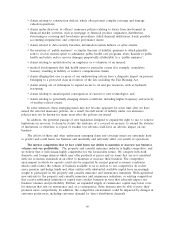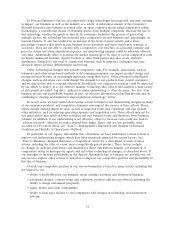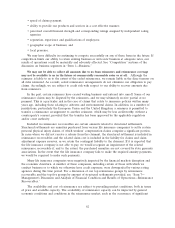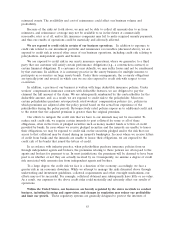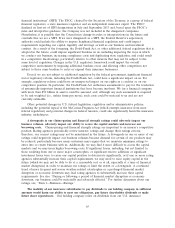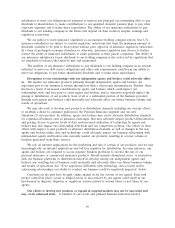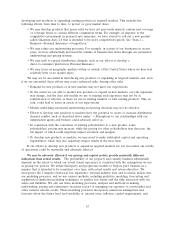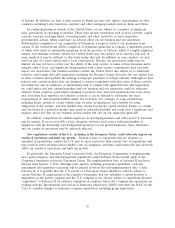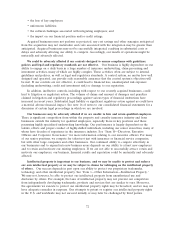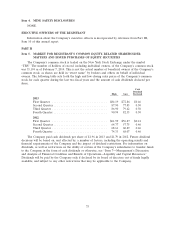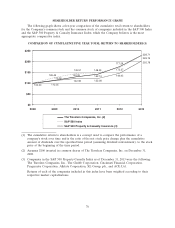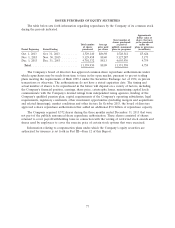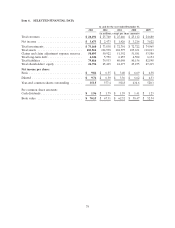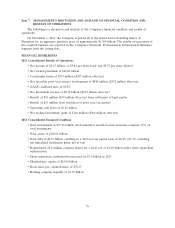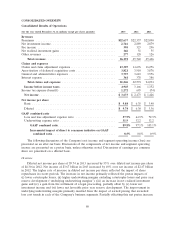Travelers 2013 Annual Report Download - page 80
Download and view the complete annual report
Please find page 80 of the 2013 Travelers annual report below. You can navigate through the pages in the report by either clicking on the pages listed below, or by using the keyword search tool below to find specific information within the annual report.of Ireland. In addition, we have a joint venture in Brazil and may also explore opportunities in other
countries, including Latin American countries and other emerging markets such as India and China.
In conducting business outside of the United States, we are subject to a number of significant
risks, particularly in emerging economies. These risks include restrictions such as price controls, capital
controls, currency exchange limits, ownership limits and other restrictive or anti-competitive
governmental actions, which could have an adverse effect on our business and our reputation.
Following the completion of our acquisition of Dominion, a larger portion of our premiums from
outside of the United States will be comprised of premiums generated in Canada, a substantial portion
of which will consist of automobile premiums from the province of Ontario, which is a highly-regulated
market. Our business activities outside the United States may also subject us to currency risk and, in
some markets, it may be difficult to effectively hedge that risk. In addition, in some markets, we may
invest as part of a joint venture with a local counterparty. Because our governance rights may be
limited, we may not have control over the ability of the joint venture to make certain decisions and/or
mitigate risks it faces, and significant disagreements with a joint venture counterparty may adversely
impact our investment. Our business activities outside the United States also subject us to additional
domestic and foreign laws and regulations, including the Foreign Corrupt Practices Act and similar laws
in other countries that prohibit the making of improper payments to foreign officials. Although we have
policies and controls in place that are designed to ensure compliance with these laws, if those controls
are ineffective and an employee or intermediary fails to comply with applicable laws and regulations,
we could suffer civil and criminal penalties and our business and our reputation could be adversely
affected. Some countries, particularly emerging economies, have laws and regulations that lack clarity
and, even with local expertise and effective controls, it can be difficult to determine the exact
requirements of, and potential liability under, the local laws. For example, in some jurisdictions,
including Brazil, parties to a joint venture may, in some circumstances, have liability for some
obligations of the venture, and that liability may extend beyond the capital invested. Failure to comply
with local laws in a particular market may result in substantial liability and could have a significant and
negative effect not only on our business in that market but also on our reputation generally.
In addition, competition for skilled employees in developing markets and other non-U.S. locations
may be intense. If we are not able to hire, integrate, motivate and retain a sufficient number of
employees with the knowledge and background necessary for our global businesses, those businesses
and our results of operations may be adversely affected.
New regulations outside of the U.S., including in the European Union, could adversely impact our
results of operations and limit our growth. Insurance laws or regulations that are adopted or
amended in jurisdictions outside the U.S. may be more restrictive than current laws or regulations and
may result in lower revenues and/or higher costs of compliance and thus could materially and adversely
affect our results of operations and limit our growth.
In particular, the European Union’s executive body, the European Commission, is implementing
new capital adequacy and risk management regulations called Solvency II that would apply to the
Company’s businesses across the European Union. The implementation date of Solvency II has been
delayed until January 1, 2016, although some aspects, including governance guidelines, own-risk
assessments and regulatory reporting, will be phased in before the full implementation date. Under
Solvency II, it is possible that the U.S. parent of a European Union subsidiary could be subject to
certain Solvency II requirements if the regulator determines that the subsidiary’s capital position is
dependent on the parent company and the U.S. company is not already subject to regulations deemed
‘‘equivalent’’ to Solvency II. In addition, regulators in countries where the Company has operations are
working with the International Association of Insurance Supervisors (IAIS) (and with the NAIC in the
U.S.) to consider changes to insurance company supervision, including group supervision.
70


